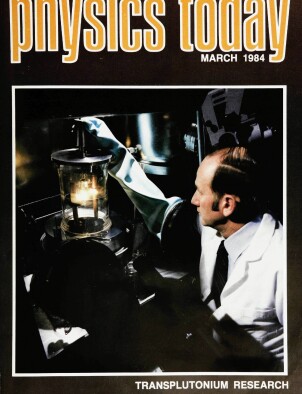Modifying materials by intercalation
DOI: 10.1063/1.2916162
For the past decade, materials research has focused on synthesizing new materials and generating new structural arrangements that exhibit specific desired properties. Some of the greatest advances in this area have come out of work on intercalation compounds, which are formed by the insertion of atomic or molecular layers of a guest chemical species—an intercalant—between layers in a host material. Figure 1 illustrates the basic structure of intercalation compounds. Part a of the figure depicts graphite intercalated with lithium; this structure is described as “commensurate,” because the atoms in each layer of guest material are in registry with those in the neighboring layers of the host material. Part b of the figure shows the incommensurate nature of graphite intercalated with ferric chloride. Although graphite intercalation compounds have been synthesized for over 150 years, it is only very recently that methods have been perfected to the point that one can prepare materials with specific structures and properties. These advances in materials synthesis, coupled with current theoretical interest in two‐dimensional physics, have contributed to the current high level of interest in graphite intercalation compounds.
This article is only available in PDF format
References
1. J. E. Fischer, T. E. Thompson, PHYSICS TODAY, July 1978, page 36.
2. F. R. Gamble, T. H. Geballe, Treatise on Solid State Chemistry, N. B. Hannay, ed., Plenum, New York (1976), page 89.
3. Proceedings of the Conference on Intercalation Compounds of Graphite, La Napoule, France, 1977, F. L. Vogel, A. Hérold, eds., (Materials Science and Engineering volume 31) Elsevier Sequoia, Lausanne (1977);
Proceedings of the Second Conference on Intercalation Compounds of Graphite, Provincetown, Mass., 1980, F. L. Vogel, ed., Synthetic Metals 2 (1980);
3 (1981).
M. S. Dresselhaus, G. Dresselhaus, Advances in Physics 30, 139 (1981).
Proceedings of the Yamada Conference IV on the Physics and Chemistry of Layered Materials, Sendai, Japan, 1980,
Y. Nishina, S. Tanuma, H. W. Myron, eds., Physica 105B (1981),
S. A. Solin, Adv. Chem. Phys. 49, 455 (1982).https://doi.org/ADCPAA4. Physics of Intercalation Compounds, L. Pietronero, E. Tosatti, eds., Series in Solid‐State Sciences 38, Springer, Berlin (1981).
5. Physics and Chemistry of Materials with Layered Structures, Vol. 6, F. Levy, ed., Reidel, Dordrecht, (1979).
6. A. Hérold in reference 5, page 323.
7. A. Erbil, A. R. Kortan, R. J. Birgeneau, M. S. Dresselhaus, Phys. Rev. B28, 6329 (1983).
8. V. L. Pokrovsky, A. L. Talapov, Sov. Phys. JETP 51, 134 (1980).https://doi.org/SPHJAR
9. D. H. McDaniel, P. Boolchand, W. J. Bresser, P. C. Eklund, Intercalated Graphite, M. S. Dresselhaus, G. Dresselhaus, J. E. Fischer, M. J. Moran, eds., (Proc. Natl. Materials Res. Soc. Symposia, volume 20), Elsevier‐North Holland, New York (1983), page 377.
10. T. Ohno, K. Nakao, H. Kamimura, J. Phys. Soc. Japan. 47, 1125 (1979).https://doi.org/JUPSAU
11. S. Y. Leung, G. Dresselhaus, Phys. Rev. B24, 3490 (1981).
12. J. E. Fischer in reference 5, page 481.
13. E. McRae, D. Billaud, J. F. Marêche, A. Herold, Physica B99, 489 (1980).
14. K. Higuchi, H. Suematsu, S. Tanuma, J. Phys. Soc. Japan 48, 1532 (1980).https://doi.org/JUPSAU
15. M. S. Dresselhaus, J.‐P. Issi, J. Heremans, Phys. Rev. B27, 1333 (1983).https://doi.org/PRBMDO
16. F. J. DiSalvo, S. A. Safran, R. C. Haddon, J. V. Wazczak, J. E. Fischer, Phys. Rev. B20, 4883 (1979).https://doi.org/PRBMDO
17. Yu. S. Karimov, Zh. Eksp. Teor. Fiz. 65, 261 (1973); https://doi.org/ZETFA7
M. Suzuki, H. Ikeda, H. Suematsu, Y. Endoh, H. Shiba, M. T. Hutchings, J. Phys. Soc. Japan 49, 671 (1980).https://doi.org/JUPSAU18. M. Elahy, M. Shayegan, K. Y. Szeto, G. Dresselhaus, Synthetic Metals 8, 35 (1983).https://doi.org/SYMEDZ
19. S. Tanuma, Y. Iye, in reference 4, page 298.
R. Al‐Jishi, Phys. Rev. B28, 112 (1983); https://doi.org/PRBMDO
A. Shimizu, H. Kamimura, Synthetic Metals 5, 301 (1983).https://doi.org/SYMEDZ
More about the Authors
Mildred S. Dresselhaus. Massachusetts Institute of Technology, Cambridge.




